Hazard Signs & Classifications (ADR)
The 'European Agreement Concerning the International Carriage of Dangerous Goods by Road', in French, the ‘Accord Dangerous Routier’, and from this point on known as ADR, was brought into force by the United Nations on 29th January 1968. This document has 2 Annexes; Annex A which defines the goods and their requirements for carriage, and Annex B which lays down the specifications and conditions of the vehicles performing the carriage.
The regulations are split into 9 Parts or Chapters and margined for reference. In October 1992, the ADR regulations were reformatted to a more user-friendly format. The books are in 2 volumes of approximately 1200 pages. These books have corrigenda issued to them regularly and are reprinted/updated every 2 Years.
Hazard Classifications
Dangerous goods must be classified in accordance with the requirements in ADR and assigned a UN (United Nations) number, name, description and packing group (where appropriate) as indicated in the Dangerous Goods list in ADR. They are therefore assigned to different classes depending on their predominant hazard which can be seen below.
Please also note that, for packing purposes, certain substances are assigned a packing group:
Packing Group I - substances presenting a high danger
Packing Group II - substances presenting a medium danger
Packing Group III - substances presenting a low danger
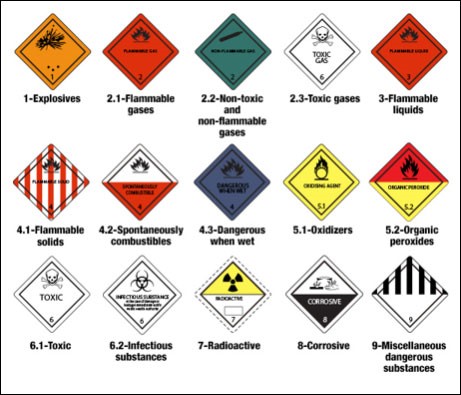
UN Hazard Warning Diamonds
The UN Model Regulations use a classification system in which each dangerous substance or article is assigned to a class depending upon the nature of the danger it presents. As can be seen above, there are 9 Classes, some of which are sub-divided, as detailed below.
CLASS 1 – Explosives
Although explosives can behave violently when suitably initiated, they are designed to be stable and insensitive under normal surface conditions. This means that they can be safely handled and transported by land and sea, so long as they are not subjected to violent shock, as in a high-speed traffic accident, or worse, allowed to heat up in a fire.
There are 6 divisions in Class 1, the divisions show how the explosives will react and behave when initiated. The items are also assigned one of 13 Compatibility Group letters, basically to indicate which types may travel safely with which.
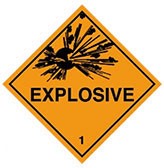
Explosives are declared as NEQ (Net Explosive Quantity) when described in the transport document, separate to the gross weight.
Division 1.1 – Mass explosion hazard
Division 1.2 – Projection hazard only
Division 1.3 – Fire hazard, minor explosion or minor projection hazard
Division 1.4 – Minimal hazard
Division 1.5 – Blasting agents
Division 1.6 – Very insensitive detonating articles
CLASS 2 – Gases
Gases are mostly carried under pressure to reduce their volume, and as a result, also save space in transport and storage. This pressure itself creates a danger if it is released suddenly. The pressure never dissipates, unlike heat, which is transferred to or from the surroundings until a uniform temperature prevails.
Applying pressure to gases will reduce their volume, but if they turn to liquid under pressure, the volume is reduced much further several hundred times. Some gases liquefy under pressure at normal temperatures, e.g. the liquefied petroleum gases chlorine, and ammonia.

But some, of the permanent gases, will only liquefy if they are also refrigerated down to very low (critical) temperatures, e.g. as low as - 269° C for liquid helium.
These include oxygen, nitrogen, hydrogen, helium, neon, and argon. Once liquefied, they have to be contained in special heavily insulated containers to prevent them from warming up. The extreme cold creates a danger if cold metal, etc. is accidentally touched without protection. Also, an escape of very cold gas creates a breathing danger, causing direct damage to the lungs, or to local oxygen starvation.
Class 2 gases have three Divisions:
Division 2.1 – Flammable Gases
Division 2.2 – Non-flammable and non-toxic gases
Division 2.3 – Toxic-gases
Unfortunately, as is the case in everything we do, we can add one unreliable ingredient into the mix, humans (see Feyzin and Los Alfaques Disasters below).
The Feyzin disaster
On 4th January 1966 at a refinery near the town of Feyzin, 10 kilometres (6 miles) south of Lyon, France, an LPG spill occurred when an operator who was draining water from a 1,200 m³ pressurised propane tank dropped the spanner through a grating and could not retrieve it. As a result, he was unable to shut off the valve and the resultant cloud that emanated from the tank once the water was exhausted and the liquid propane drained out, turned to vapour and spread out from the tank.
Shortly after, the cloud of vapour was ignited by the hot exhaust of a passing car on an adjoining road. Following the incident, the refinery and surrounding countryside resembled a war zone.
Los Alfaques disaster
On 11th July 1978 in Alcanar, near Tarragona, Spain, a tanker carrying 23 tonnes of highly flammable liquefied propylene was involved in a road traffic accident on the N-340, 2 km south of the town of Sant Carles de la Ràpita. The accident resulted in an explosion as the tanker passed alongside the nearby seaside campsite of Los Alfaques, which was packed with holidaymakers.
In this incident, the tanker was overloaded by 4 tonnes. Equally, the driver had been instructed to take this minor road, rather than take the A7 motorway which ran parallel to it, to avoid paying the obligatory road toll.
These two events confirm why there is a need for ADR and why safety in all modes of transport should be adhered to at all times – there can be NO shortcuts.
CLASS 3 – Flammable Liquids
Some flammable liquids derive from petroleum, such as petrol and kerosene, whereas others are manufactured through natural or industrial processes such as alcohol.
Vapours are created when some molecules in the liquid have sufficient energy and are moving with sufficient velocity to break clear of the surface into the air space above. The warmer the liquid, the more molecules reach this energy and velocity level, and the faster the vapour is formed.
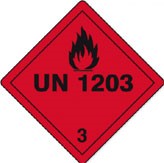
The vapours are invisible, and always much heavier than air. They will flow downhill and collect at the lowest point.
Flammable liquids are placed in Packing Groups according to their boiling point and flashpoint.
|
PACKING GROUP |
INITIAL BOILING POINT |
FLASHPOINT (CLOSED CUP) |
|
Packing Group I |
The boiling point below 35°C |
|
|
Packing Group II |
The boiling point above 35°C |
Flashpoint below 23°C |
|
Packing Group III |
The boiling point above 35°C |
Flashpoint >23°C and < 60°C |
CLASS 4.1 / 4.2 / 4.3
Flammable solids, are spontaneously combustible and dangerous when wet.
CLASS 4.1 – Flammable Solids
These will burn easily, more so than ordinary combustible materials such as wood and paper. The burning may be fierce and rapid, creating great heat.
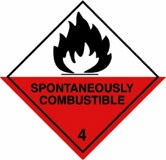
Some 4.1 are desensitised explosives, e.g. wetted trinitrotoluene (TNT) which would otherwise be in Class 1. Some are self-reactive, and are liable to break down chemically, if they get above a certain temperature, or are subjected to shock etc.
CLASS 4.2 – Spontaneously Combustible
Division 4.2 Goods are either solids or liquids. They will ignite spontaneously in contact with oxygen. They must be kept in airtight packages or as liquids under an inert gas or liquid blanket. Pyrophoric materials will ignite within five minutes of coming into contact with air and are always assigned to Packing Group I. Other materials will ignite only when in large amounts and after long periods. These are in Packing Group II or III, depending on classification tests
CLASS 4.3 – Dangerous When Wet
Division 4.3 Goods react with water, either as a liquid or as vapour, and generate flammable gas. This can be ignited by the heat of the reaction. They must be kept in watertight containers, hermetically sealed to avoid the entry of moisture or water vapour
CLASS 5.1 / 5.2
Oxidising Agents and Organic Peroxides
CLASS 5.1 - Oxidising Agents
Because of their high oxygen content, these are often reactive materials. They may react with other flammable or combustible materials, and the heat generated may start the latter burning.
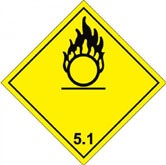
The agents then supply the oxygen to keep them burning without any help from oxygen in the air, as is the case with normal combustion.
Such fires may, therefore, break out and continue in confined spaces, e.g. inside cargo holds and once started may be difficult to extinguish. Blanketing with powder or foam is useless, as the oxygen is already present in the agent underneath.
Some oxidisers can be explosive if heated strongly, particularly in the presence of carbon. Ammonium nitrate mixed with hydrocarbon oil, e.g. diesel, becomes a powerful explosive, much used in the extractive industries, and by terrorists.
CLASS 5.2 – Organic Peroxides
The molecule contains structures containing carbon (organic) linked by a double oxygen bond (peroxide). Thus the fuel and the oxygen are together in the same molecule, making them even more liable to ignition than a separate combustible material.
They are designed to be reactive for several industrial purposes, and may consequently be unstable, and sometimes explosive. When they are first developed, they may be classified as either Class 1 or Class 5.2 generally depending on the intended end-use. Based on their chemical structure alone, they could be considered as either.
They often have to be maintained under refrigeration to keep them inactive, and then the temperature must be carefully controlled. Otherwise, if they exceed a certain temperature specific to the material, they will start to decompose rapidly, similar to the self-reactive materials in Class 4.1, resulting in uncontrollable progress towards fire or explosion.
Because of their reactive nature, they can be very damaging to the human body, particularly the eyes.
CLASS 6.1 / 6.2
Toxic and Infectious Substances
CLASS 6.1 – Toxics Sign
These are chemical poisons that can damage the human body, in whole or in part. They must not be allowed to get inside the body, through swallowing, breathing in, or absorption through the skin.
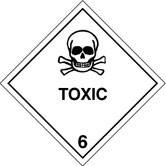
The toxics range in power from those which kill in minutes, e.g. the cyanides, to those which would injure but not necessarily kill, so long as the dose was not excessive, e.g. the chlorinated hydrocarbons toxics in Class 6.1 can be in solid or liquid form.
Toxic gases are in Class 2.3.
Generally, 6.1 must not be carried with foodstuffs, however, there are exceptions.
CLASS 6.2 – Infectious Substances
Division 6.2 Goods contain pathogens, i.e. micro-organisms that cause infectious disease in humans or animals. They are graded for danger for transport into one of three groups, of which only the first two are considered dangerous for transport on infectious grounds.
Category A: Capable of causing permanent disability, life-threatening or fatal disease to humans or animals. These are assigned to UN 2814. Some examples are:
- Ebola Virus
- Hepatitis B Virus
- Lassa Virus
- Rabies Virus
Infectious substances which cause disease only in animals are assigned to UN 2900. Some examples are:
- African Horse Sickness Virus
- Foot & Mouth Disease Virus
- Sheep-Pox Virus
- Vesicular stomatitis Virus
CLASS 7 – Radioactive Substances
These radioactive materials are materials containing unstable atoms that change their structure spontaneously in a random fashion over some time period.
As each atom changes, it emit invisible radiation that may cause chemical or biological change-ionising radiation. This can damage the body in some way or other, depending on the type of radiation, and the duration of the exposure.
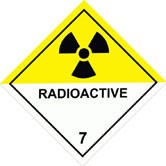
Ionising radiation is generally dangerous to the human body, depending on the type of radiation, the dose and the duration of the exposure.
Some radioactive materials may also have other hazardous properties, and packages may, therefore, carry other UN warning signs to indicate subsidiary risks.
Radioactive packages are perfectly safe to handle and transport because the packaging acts as a shield. They will not create any health hazards for transport workers. However, the rule is to keep any dose of ionising radiation to a minimum. The dose, in turn, depends on:
- The strength of the radioactive source, the "activity"
- The distance from the source
- The barriers around the source
- The exposure time
Excepted Packages
The radiation level at the surface must be below 5 mSv/hour.
The Sievert symbol, Sv is a derived unit of ionizing radiation dose in the International System of Units (SI) and is a measure of the health effect of low levels of ionizing radiation on the human body.)
The packages must be declared as radioactive on the declaration, but they do not need to be labelled. In default of other hazardous properties, they can be carried as ordinary goods.
CLASS 8 – Corrosive Substances
These are highly reactive materials that produce positive chemical effects, resulting in changes in the affected materials.
For this reason, corrosives are used extensively in industry to produce a wide range of transformations and effects.
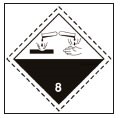
This active nature can obviously be very damaging to the body. They work from outside the body by destroying the tissue, in the opposite way to the toxins, which work from inside the body on the various organs and life systems.
Corrosives are described as either acids or alkalis. Acids react with metals which are generally strong and flexible, to produce salts, which can be fragile crystals that are soluble in water. Inorganic acids include carboxylic, acetic, formic, and benzoic, and fatty acids like oleic, palmitic, and stearic.
Common alkalis are sodium and potassium hydroxide, and ammonium hydroxide. These are very corrosive to skin, eyes and mucous membranes. Alkalis neutralise acids, but the reaction may be strong and create a lot of heat very rapidly. This can cause the water in the solution to flash off to steam violently, throwing the material aside in a dangerous fashion.
Corrosives are placed in Packing Groups according to their ability to cause full-thickness destruction of intact skin tissue within a certain observation period, starting after a certain exposure time, measured in minutes, hours, or days.
There are strict requirements on the carriage of acids & alkalis during Sea journeys (IMDG Regulations)
CLASS 9 – Miscellaneous Dangerous Substances and Articles
Class 9 covers substances and articles which during carriage, present a danger not covered by the heading of other classes.
Such products have properties that cannot be included elsewhere in the UN Class system, or which have several disconnected dangers crossing two or more Class boundaries.
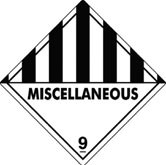
These also include hazardous substances and wastes, such as environmentally hazardous substances, miscellaneous articles and substances that are transported at elevated temperatures such as tar (bitumen) and also some foodstuffs
An example of this diversity is self-inflating life rafts, which include in the package:
- A large compressed gas cylinder, usually carbon dioxide, inflates the raft and its canopy when it hits the water.
- Various explosive flares, coloured smoke candles, etc. to attract the attention of rescuing air and sea craft.
- Flammable solid materials for heating food and providing warmth.
- Fabric repair kits, containing flammable liquids as the base for adhesive solutions.
The Class sign is unique in the UN system in that it gives no indication of the particular danger, which can only then be obtained from written information.
There are two UN numbers in Class 9 for environmentally hazardous materials. UN 3077 Environmentally Hazardous Substance Solid N.O.S and UN 3082 Environmentally Hazardous Substance Liquid N.O.S.
Hazardous Material includes several other products identified which may not be included in the above list of Classes 1 - 9. These are classified as "Obnoxious" and for the purposes of carriage would fall within Class 9. These include:
- Animal waste
- Refuse
- Hospital waste
- Pressurised gases
- Pressurised liquids
- Asbestos
There are other products that would similarly fall within the list above, a further example which is not as common in the UK as it is in certain other European member states includes human waste, where cesspits from rural domestic dwellings require emptying and their contents transported elsewhere.
The following links will assist in obtaining further information on ADR and (in our view) should be considered definitive reading.
The Carriage of Dangerous Goods and Use of Transportable Pressure Equipment Regulations 2009